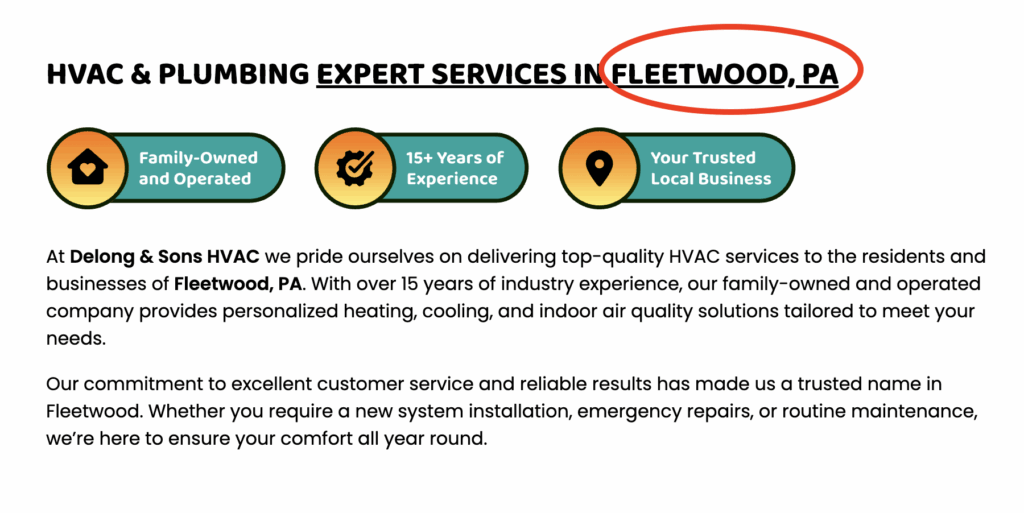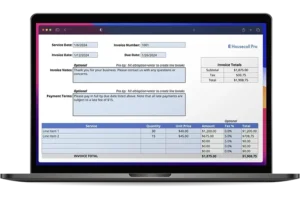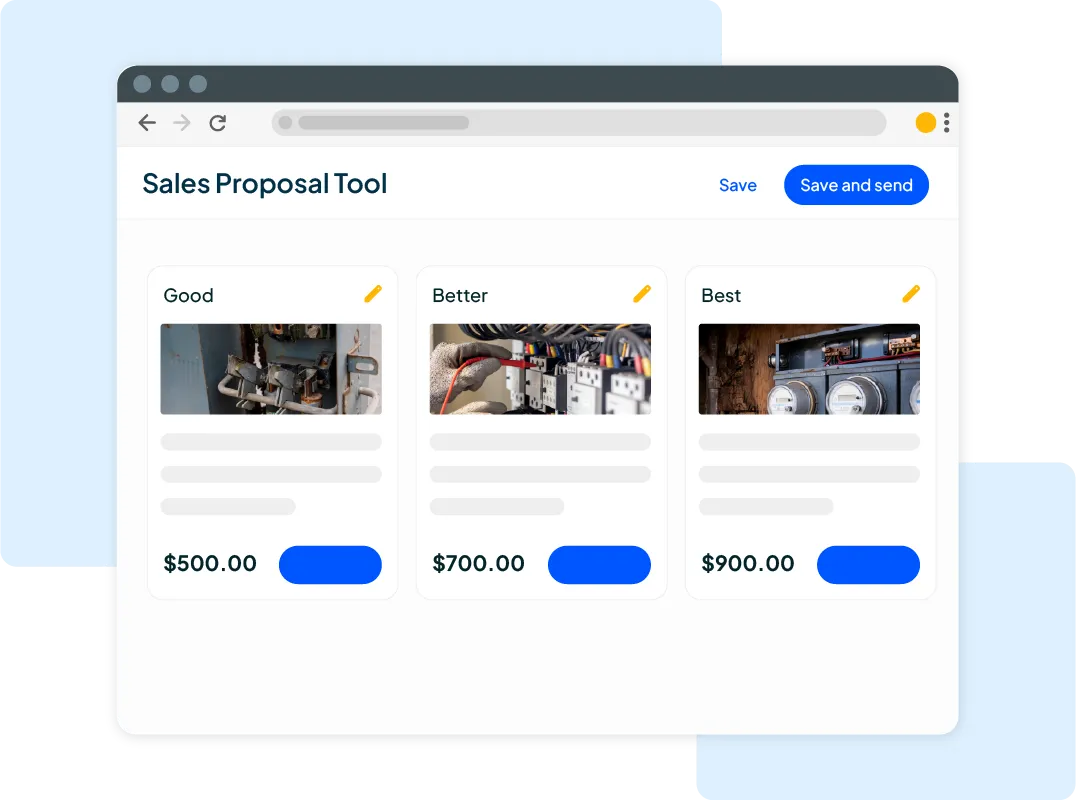Want to win more jobs with less effort?
Grow your business and send quick quotes with our home service software.

Want to see your potential revenue?
See what businesses like yours earn with Housecall Pro in 1 - 2 minutes.

If you’re running an HVAC business, you know how tough it can be to stand out online. Big companies dominate Google search results, and paid ads can quickly eat into your margins. That’s where search engine optimization (SEO) comes in. With the right approach, you can attract people who are actively searching for HVAC services, build lasting visibility, and get more leads—all at a lower cost than ads.
Not sure where to start? This guide walks you through 14 practical steps to create a smart SEO strategy that helps your business rank higher, earn trust with potential customers, and generate steady leads.
Key takeaways
Here's a quick overview of how you can make the most of your HVAC SEO strategy:
Focus on local SEO: Optimize your Google Business Profile and use city-based keywords to rank higher in nearby HVAC searches.
Create valuable content: Write local blog posts and service pages that answer real customer questions to boost visibility and trust.
Build credibility: Earn consistent reviews and backlinks from local sites to strengthen trust with Google and potential customers.
Track and refine results: Use tools like Google Analytics and Search Console to monitor rankings, traffic, and conversions.
HVAC SEO services: Should you hire an expert?
SEO can be a game-changer for your HVAC business, but it takes time, tools, and know-how to do it right. Hiring an expert can help you get results faster, but it’s not the perfect fit for every business. Here’s a quick look at the pros and cons to help you decide.
Pros
- Brings deep knowledge of SEO and the HVAC trade
- Saves you time so you can focus on running your company
- Provides access to advanced tools and reporting you may not have on your own
Cons
- Requires paying monthly retainers, which can be costly for small businesses
- May lack understanding of your local market or specific business needs
- Still demands your time and oversight to ensure work aligns with your brand
Even if you hire someone, knowing the SEO basics helps you ask the right questions and recognize quality work when it’s delivered.
Local SEO for HVAC
Local SEO is a fundamental part of HVAC marketing. It’s what helps your business show up when someone searches for “AC repair near me” or “furnace installation in [your city].” Since most of your HVAC customers are homeowners in and around your area, perfecting your local SEO can be the difference between getting the call or losing out to a competitor.
Step 1: Optimize your Google Business Profile

If you don’t already have a Google Business Profile, create one. It’s often the first thing people see in local search. A complete, up-to-date profile also improves your chances of ranking in the Local Pack (that box with the map and highlighted listings at the top of Google results).
Here are the basics to include:
- Your business name, address, and phone number (NAP)
- Your service area, hours, and contact info
- Photos of your team, trucks, and recent work
- A list of the services you offer (duct cleaning, AC installation, furnace repair, etc.)
Jensen Savage, CEO and founder of Savage Growth Partners, recommends regularly updating your profile with photos, services, and review replies. “It’s one of the highest-leverage assets for local trust and conversions,” she says.
Step 2: Use location-specific keywords

Incorporating location-specific keywords into your website content, service pages, and blog posts helps search engines connect your business with local customers. Savage recommends organizing your keywords by both service type and intent. Create separate pages for each major service—like installation, repair, or maintenance—and target high-intent phrases like “emergency AC repair in Denver” or “furnace tune-up near me.”
Don’t just sprinkle them in—use them naturally in page titles, URLs, meta descriptions, headings, and throughout your copy. This makes it easy for Google to understand where you operate and increases your chances of appearing in local search results.
Step 3: Build local citations
Citations are online mentions of your business on other websites. Apart from your Google Business Profile, list your company on trusted directories such as:
- Yelp
- Angi (formerly Angie’s List)
- Bing Places
- Nextdoor
- Better Business Bureau (BBB)
- Local chamber of commerce
- Facebook Business Page
Pro tip: Keep your business information consistent across directories. Even small differences (like “St.” vs. “Street”) can hurt rankings, so double-check everything.
Step 4: Earn and manage customer reviews
Good reviews build trust and help you rank higher, so send happy customers a direct link to leave a Google review. Respond to every review—even the negative ones—with a professional, timely reply. Data from BrightLocal shows that businesses that consistently respond to all reviews are far more likely to earn customer trust and convert new business.
Pro tip: For more five-star reviews without any extra work, use Housecall Pro to send automated review requests right after a job is done.
On-page SEO for HVAC
On-page SEO focuses on improving the parts of your HVAC website that you control. This includes things like keywords, blog posts, page titles, and other content. When you optimize these elements, you help Google understand what your business does and where you operate, which can improve your search rankings.
Step 5: Do keyword research
Use tools like Google Keyword Planner or SEMrush to find what your customers are actually searching for online. Look for high-intent keywords like “HVAC repair Denver” or “AC tune-up near me” that indicate the searcher is ready to hire.
Try to mix in service and location keywords, like:
- “Duct cleaning in Austin”
- “Furnace repair Seattle”
- “Emergency HVAC Houston”
Step 6: Create blog content
Posting fresh content helps you show up in more searches and establishes you as a trustworthy, knowledgeable source. Schedule time to write blog posts, FAQs, or guides that answer common questions in your area.
Keep your content helpful and specific. Local content often performs better than generic advice, so write for your community. Examples might be:
- “How to prepare your AC for summer in Phoenix”
- “5 signs your furnace needs replacement in Minneapolis”
- “Average HVAC repair costs in 2025”
Step 7: Optimize page titles and meta descriptions

Your page titles and meta descriptions are what searchers see before clicking onto your site, so make them compelling and relevant. Write clear, keyword-rich titles that match what people are searching for. For example, an HVAC company in Denver could use:
- Title: “24/7 AC Repair in Denver | [Your Business Name]”
- Meta description: “Get fast, reliable AC repair in Denver. Call [Your Business Name] today for same-day service and upfront pricing.”
Pro tip: Keep page titles under 60 characters and meta descriptions under 155 characters so they won’t get cut off in search results.
Step 8: Use headers and structure
Break up your content with headers. This makes it easier to scan and tells search engines what each section is about.
For example, this page is divided into clear sections with H2s and H3s. Each header sets expectations, and paragraphs are broken into digestible pieces for easier reading.
Here’s how to structure your page:
H1: The main title of your page (use just one per page).
H2: Primary sections that organize your content.
H3: Subsections or topics within each main section.
H4: Additional details or supporting points (use only when necessary).
Pro tip: Add bullet points, numbered lists, and tables to highlight key points or break up large chunks of text.
Step 9: Optimize images
Images show customers your work, but they also play a role in SEO. Use descriptive file names (e.g., “denver-ac-installation.jpg not “IMG_1234”) and alt text (such as “HVAC technician installing a furnace”). Bonus points if you can incorporate your keywords naturally here.
Always compress large image files to keep your site fast. Page speed affects rankings and user experience.
Step 10: Improve website speed and mobile experience
If your website takes more than a few seconds to load, there’s a good chance visitors will leave. Test your site with Google PageSpeed Insights and be sure it’s fast, easy to navigate, and looks great on all devices.
Get In Touch: 858-842-5746
Let us earn your trust
On average, Pros increase monthly revenue generated through Housecall Pro by 35% after their first year.
See plan options and feature breakdown on our pricing page.
Off-page SEO for HVAC
Off-page SEO focuses on building your reputation across the web. This includes getting other trusted sites to link to you, engaging with your community online, and showing Google that your business is reliable and well-regarded. The more credible signals you send, the higher your site can rank in search results.
Step 11: Build quality backlinks
Backlinks are links from other websites pointing toward yours. Think of them as votes of confidence for your business. There are a few ways to earn quality backlinks, such as:
- Asking local partners (suppliers, subcontractors, realtors) to link to your site
- Contributing tips or short articles to local news outlets or trusted community blogs
- Joining HVAC associations or trade groups that list members online
While these routes may take a bit more effort, they’re worth the quality backlinks. Avoid buying backlinks from spammy sites—they can do more harm than good to your rankings.
Step 12: Engage on social media
Social media marketing doesn’t directly improve your rankings, but it can drive traffic to your site, improve brand awareness, and build backlinks.
Focus on one to two platforms where your customers spend the most time (often Facebook, Nextdoor, and Instagram). Share helpful tips, seasonal reminders, and behind-the-scenes content. The more your posts get shared and interacted with, the more people they’ll reach.
Step 13: Partner with local businesses
Collaboration builds your network and can earn valuable mentions online. You might sponsor community events, team up with local plumbers or electricians for cross-promotion, or even offer discounts through local hardware stores.
These partnerships can help with backlinks, referrals, and more overall visibility in your area. Think of it as digital word-of-mouth. When other local businesses reference you online, it’s like a signal to the search engines that you’re a trusted part of the community.
Step 14: Monitor online reputation
Your online reputation plays a big role in how customers—and search engines—see your business. Positive reviews and mentions build trust, while negative ones can drive potential clients away.
Set up Google Alerts for your business name so you’re notified whenever someone talks about your company online. Regularly respond to reviews on platforms like Google, Yelp, Facebook, and Angi. Stay professional and courteous, even if the feedback isn’t positive. A thoughtful response shows that you care about your customers and are committed to improving their experience—something both people and Google notice.
Technical SEO for HVAC
Technical SEO helps search engines find, read, and understand your website. Even the best-written content won’t rank well if your site isn’t built and maintained properly.
Here’s what to check:
- Indexing and crawlability: Submit your XML sitemap to Google Search Console and check for broken links. A site that’s easy to crawl will show up more reliably in search results.
- Structured data (schema markup): Use tools called schema to tag important information on your site, such as your business name, services, location, and reviews. This helps Google display extra details like hours and ratings.
- HTTPS encryption: Use HTTPS so visitors see the padlock icon and know they’re safe when browsing your site. This is a trust signal for customers and a small ranking factor for Google.
- Site architecture and internal linking: Group services under clear categories (like heating, cooling, and ductwork) and link related pages together. This helps both readers and search engines find what they need.
- Performance: A slow or difficult-to-navigate website drives visitors away. So, run a speed check and make sure your site looks good on phones (since that’s where most searches happen).
Run a quick audit every few months to catch small issues and keep your site healthy.
How to measure SEO success
You don’t need to be an expert to know if your SEO is working. A few key numbers can tell you whether your efforts are paying off. These include:
- Website traffic: Look at how many people visit your site, especially from organic Google searches. More traffic means more visibility.
- Local rankings: Search for your main services (like “AC repair near me” or “furnace repair Tacoma”) and see where you rank. If you’re moving up in search results, you’re doing something right.
- Click-through rate (CTR): This shows how often people click your site after seeing it in search results. A higher CTR means your titles and descriptions are doing a good job grabbing attention.
- Bounce rate: This measures how many visitors leave your site after viewing just one page. A high bounce rate can signal that your content isn’t meeting their expectations or that your site is slow to load.
- Conversion metrics: Keep track of calls, contact forms, and online booking requests. These are the actions that turn those visitors into paying customers.
There are a few tools you can use to track these metrics, including:
- Google Analytics shows you how many people visit your site and where they come from.
- Google Search Console shows what search terms people use to find you and alerts you to technical issues.
- Moz, Ahrefs, or SEMrush: These paid tools help track keyword rankings, analyze backlinks, audit your site, and monitor competitors.
Use these metrics to adjust your strategy. If rankings and bookings improve, your SEO is working. If not, tweak content, headlines, or site speed.
HVAC SEO mistakes to avoid
You don’t need to be perfect, but even small missteps can waste time and hurt your results. Be careful to avoid these common pitfalls:
- Keyword stuffing: This happens when you cram too many keywords into your content in an attempt to rank higher on Google. Instead, focus on writing for your readers and working in keywords only where they fit naturally.
- Neglecting performance: Monitor results to double down on what works.
- Purchasing links: Only pursue authentic, high-quality links from real local sites.
- Using duplicate content: Make every page unique to maximize value.
How HVAC software can help
Keeping your SEO strategy organized takes effort, but the right tools can make it easier. Instead of juggling spreadsheets and manual follow-ups, you can automate key tasks, track results, and focus on what you do best: running your business.
Housecall Pro is built to help HVAC pros grow their business. Here’s what you can do with our HVAC software:
- Automate review requests: Automatically send review invites right after each job so you can collect more Google reviews and boost your local rankings.
- Offer online booking: Let customers schedule directly from your website or Google Business profile anytime, day or night. In fact, 41% of jobs booked via Housecall Pro come in after hours, meaning you can capture leads while you sleep.
- Track marketing performance: See which campaigns, services, and locations are generating the most calls and bookings, so you know exactly where your marketing is working.
- Automate follow-ups: Send reminders and seasonal offers that turn one-time jobs into loyal, repeat customers.
- Manage integrated customer data: View job history, payments, and service areas in one place to better understand where your best leads come from and how to reach more like them.
Try Housecall Pro for free for 14 days and see just how easy it is to manage reviews, bookings, and marketing all in one place.








